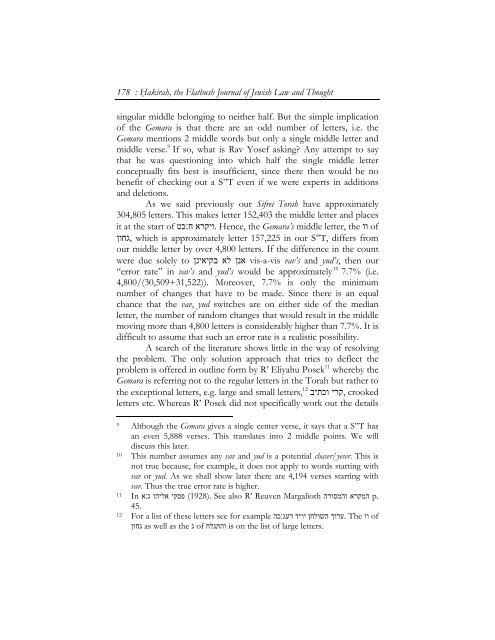Symmetrically Designed Sifrei Torah: A Quantitative Analysis - Hakirah
Symmetrically Designed Sifrei Torah: A Quantitative Analysis - Hakirah
Symmetrically Designed Sifrei Torah: A Quantitative Analysis - Hakirah
Create successful ePaper yourself
Turn your PDF publications into a flip-book with our unique Google optimized e-Paper software.
178 : Hạkirah, the Flatbush Journal of Jewish Law and Thought<br />
singular middle belonging to neither half. But the simple implication<br />
of the Gemara is that there are an odd number of letters, i.e. the<br />
Gemara mentions 2 middle words but only a single middle letter and<br />
middle verse. 9 If so, what is Rav Yosef asking? Any attempt to say<br />
that he was questioning into which half the single middle letter<br />
conceptually fits best is insufficient, since there then would be no<br />
benefit of checking out a S”T even if we were experts in additions<br />
and deletions.<br />
As we said previously our <strong>Sifrei</strong> <strong>Torah</strong> have approximately<br />
304,805 letters. This makes letter 152,403 the middle letter and places<br />
it at the start of ח׃כט .ויקרא Hence, the Gemara’s middle letter, the וו of<br />
which is approximately letter 157,225 in our S”T, differs from ,גחון<br />
our middle letter by over 4,800 letters. If the difference in the count<br />
were due solely to אנן לא בקיאינן vis-a-vis vav’s and yud’s, then our<br />
“error rate” in vav’s and yud’s would be approximately 10 7.7% (i.e.<br />
4,800/(30,509+31,522)). Moreover, 7.7% is only the minimum<br />
number of changes that have to be made. Since there is an equal<br />
chance that the vav, yud switches are on either side of the median<br />
letter, the number of random changes that would result in the middle<br />
moving more than 4,800 letters is considerably higher than 7.7%. It is<br />
difficult to assume that such an error rate is a realistic possibility.<br />
A search of the literature shows little in the way of resolving<br />
the problem. The only solution approach that tries to deflect the<br />
problem is offered in outline form by R’ Eliyahu Posek 11 whereby the<br />
Gemara is referring not to the regular letters in the <strong>Torah</strong> but rather to<br />
the exceptional letters, e.g. large and small וכתיב letters, 12 ,קרי crooked<br />
letters etc. Whereas R’ Posek did not specifically work out the details<br />
9 Although the Gemara gives a single center verse, it says that a S”T has<br />
an even 5,888 verses. This translates into 2 middle points. We will<br />
discuss this later.<br />
10 This number assumes any vav and yud is a potential chaser/yeser. This is<br />
not true because, for example, it does not apply to words starting with<br />
vav or yud. As we shall show later there are 4,194 verses starting with<br />
vav. Thus the true error rate is higher.<br />
11 In פסקי אליהו ג׃א (1928). See also R’ Reuven Margalioth המקרא והמסורה p.<br />
45.<br />
12 For a list of these letters see for example השולחן יו״ד רע .ערוך The וו of<br />
letters. is on the list of large והתגלח of ג as well as the גחון<br />
ג׃כה
















